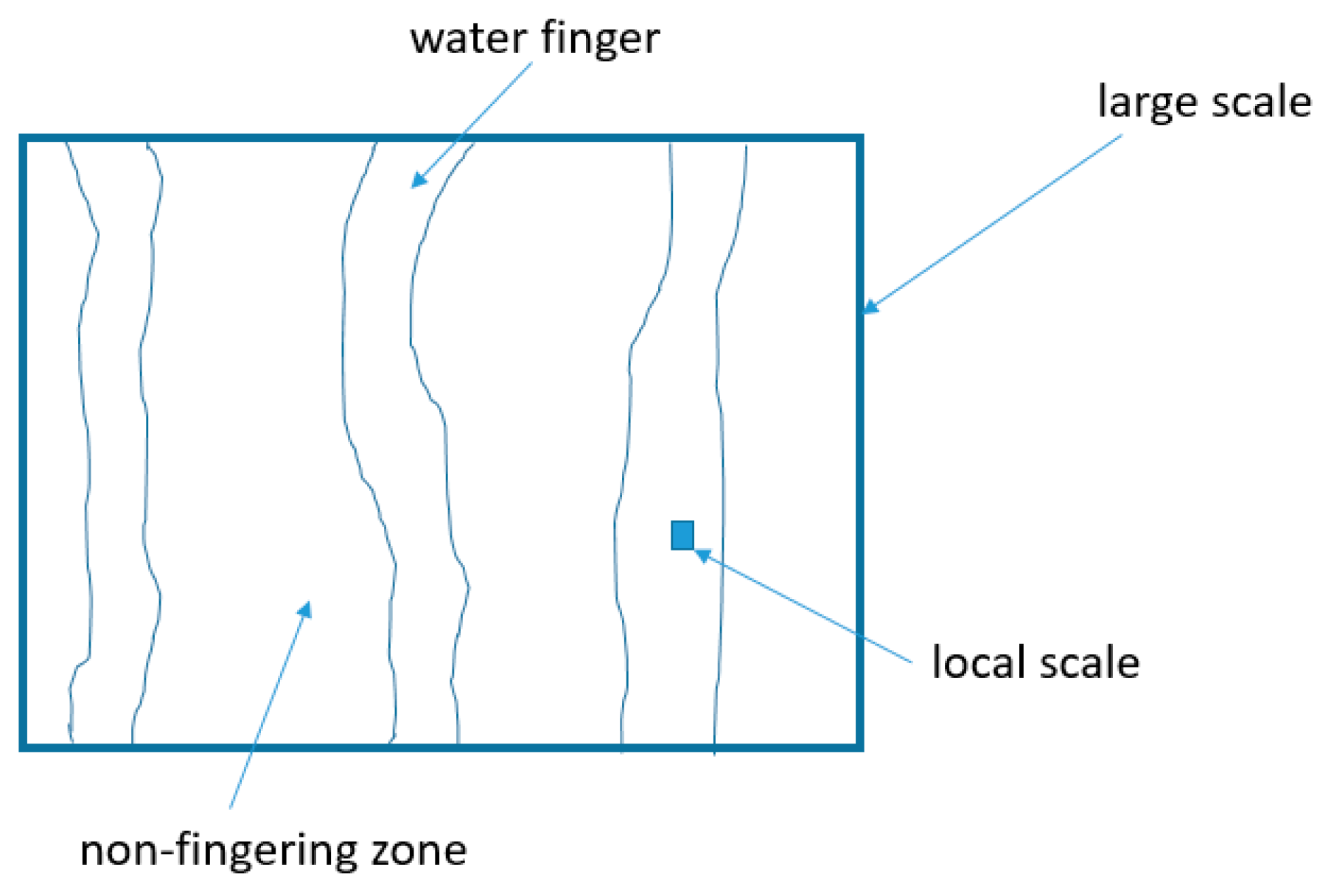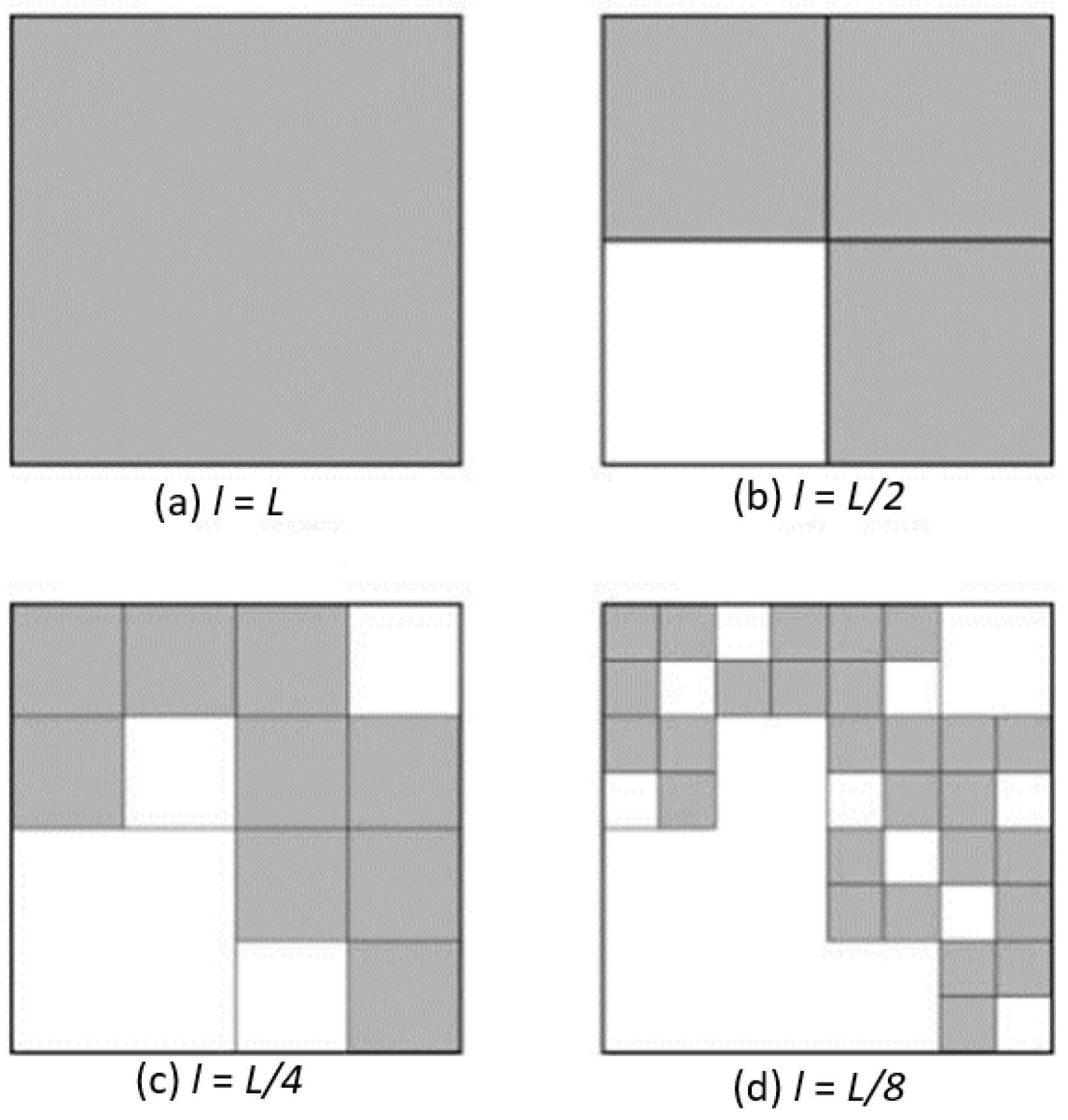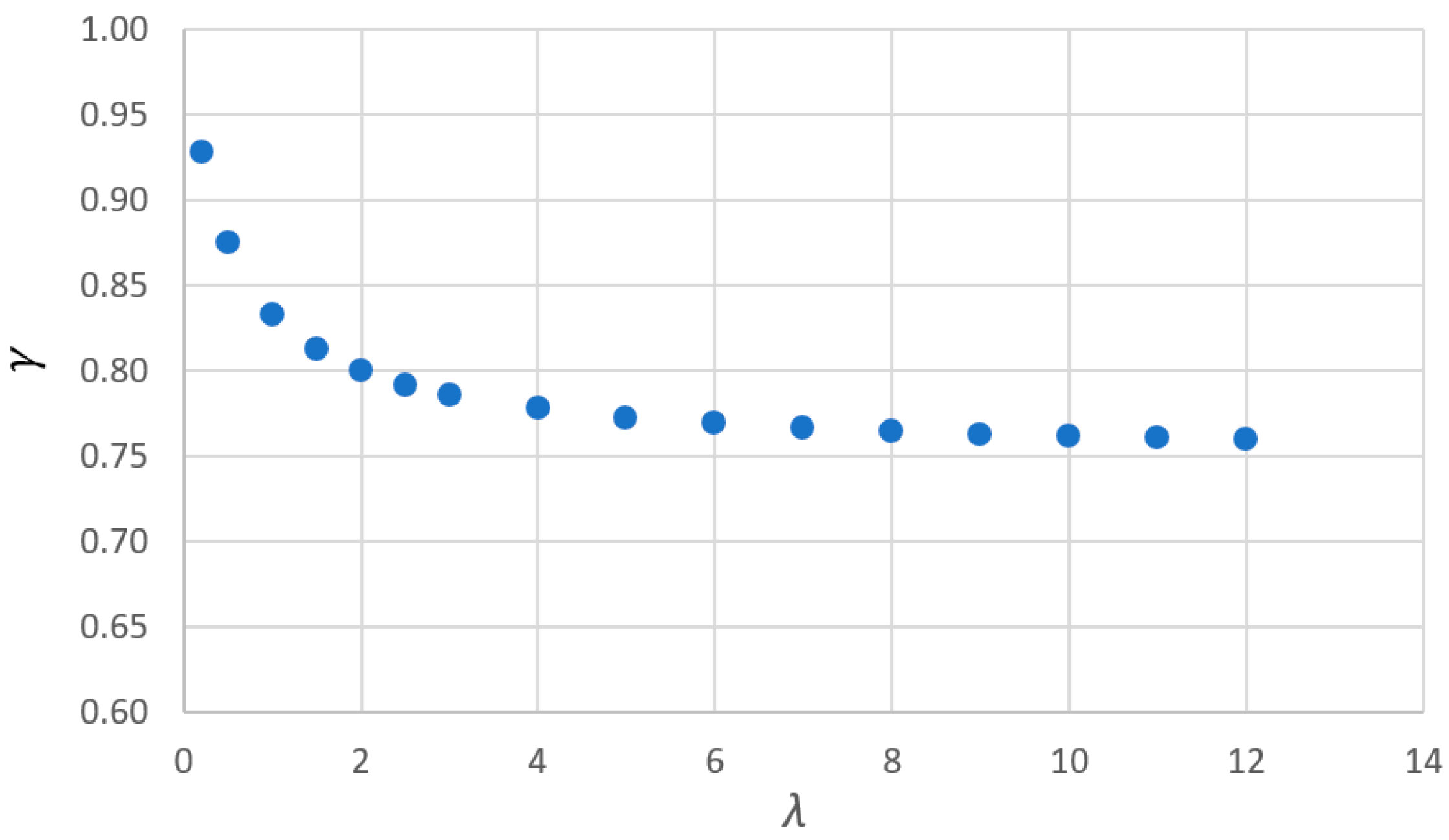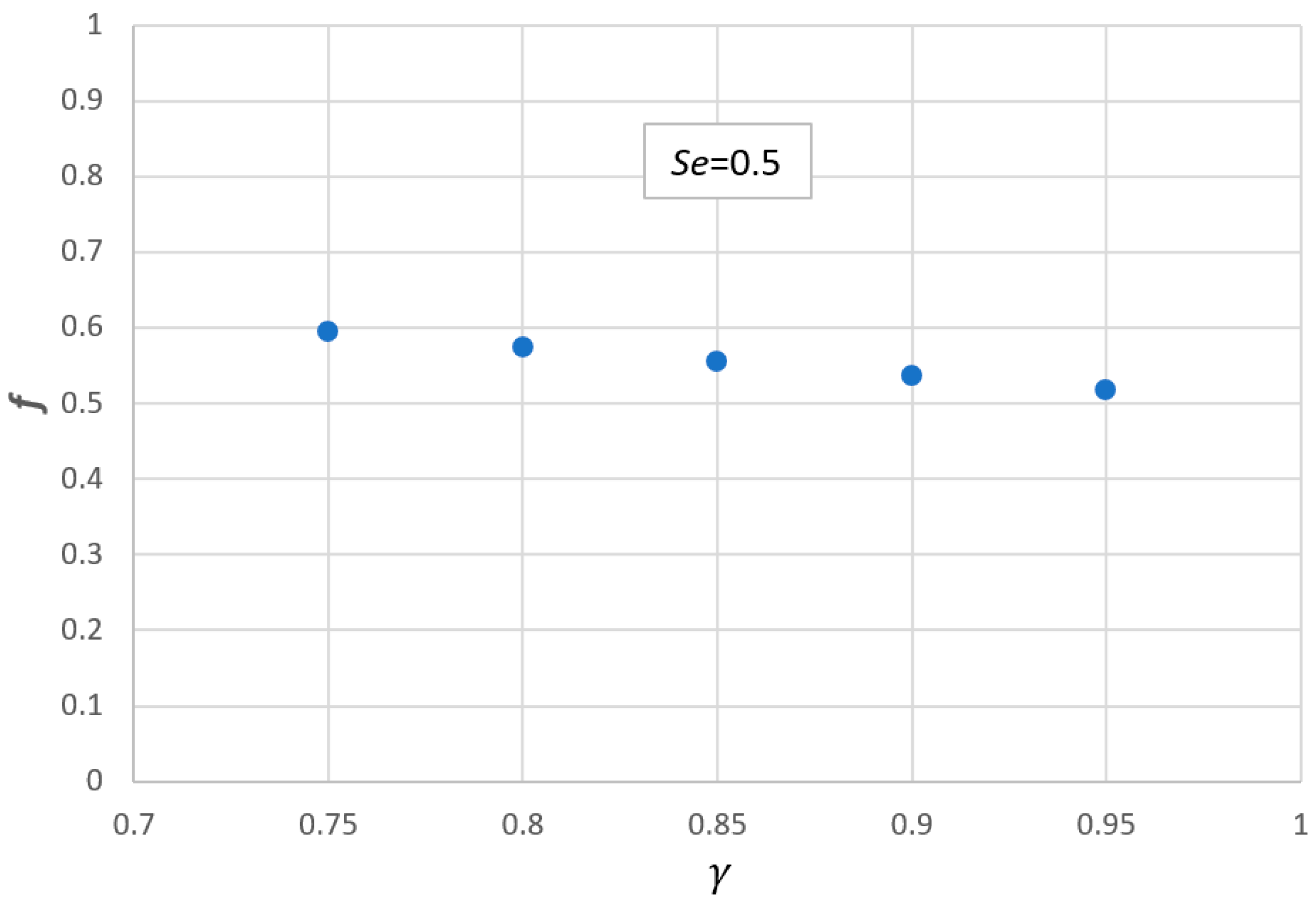This section discusses large-scale relationships of hydraulic conductivity for the fingering flow processes, based on both the optimality and fractal flow patterns, and their consistency.
2.1. The Relationship Based on the Optimality Principle
As previously indicated, Darcy–Buckingham law was developed based on the local equilibrium assumption and an additional physical principle is needed for deriving the large-scale relationship of hydraulic conductivities for the fingering flow process. We here present the detailed procedure to obtain such a relationship based on the optimality principle that water flows in unsaturated porous media in such a manner that the generated flow patterns correspond to the minimum global flow resistance. Following the common practice to determine large-scale flow parameters [
22], we focus on the steady-state flow process given that this work focuses on the fully developed fingering flow process. The steady-state water flow equation on a large scale (
Figure 1) for a homogeneous and isotropic porous medium is given as
where
x and
y are the two horizontal coordinate axes,
z is the vertical axis, and
qx,
qy and
qz are large-scale Darcy flux along
x,
y and
z directions, respectively.
To apply the optimality principle, we need to derive the expression for energy expenditure rate. The energy of unit weight of liquid water in a porous medium,
E, is given by
where
h is the average capillary pressure head within the fingers as shown in
Figure 1. The energy expenditure rate for a unit volume of porous medium can be written as
The above equation represents the rate of water energy loss within a unit volume of porous medium. Combining Equations (1) and (3) yields
Therefore, the rate of water energy loss is represented by a product of water flux and energy gradient.
Following Liu [
10,
14], we assume that the mathematical form of Darcy–Buckingham law is still applicable to the fingering process at a large scale except that the corresponding hydraulic conductivity, as discussed below, does not depend on water saturation or capillary pressure only:
The major difference between Liu [
10,
14] and the traditional unsaturated flow theories is the expression for hydraulic conductivity
K. Conventionally,
K is a function of water saturation or capillary pressure only. This is a direct result of the local equilibrium assumption that, however, is not valid for modeling fingering flow on a large scale. In other words, the water distribution within a course grid block (
Figure 1) cannot be uniquely determined by water saturation or capillary pressure alone. Additional large-scale variables are needed to accurately determine the state of subgrid water distribution. Water flux is a logical choice because it is highly relevant to the fingering flow process. Following Liu [
10,
14], we used the square of the energy gradient as the additional variable to determine the large-scale conductivity for mathematical convenience. This is equivalent to the use of water flux because water flux and the energy gradient are related to each other (Equation (5)). In this case, the large-scale hydraulic conductivity is given by
where
Ksat is the saturated hydraulic conductivity,
is the relative permeability, and the square of the energy gradient
is defined by
The optimality principle is used to derive the explicit relationship among
K,
h, and
(Equation (6)). Based on Equations (4), (5), and (7), we can write the total energy expenditure rate for the whole flow domain as
When applying the optimality principle regarding the minimization of global flow resistance, the total energy expenditure rate could be either the minimum or the maximum, depending on the given boundary conditions. For fixed
E values at boundaries, the small flow resistance will allow for large water flux and thus the absolute value of the energy expenditure rate will reach its maximum. On the other hand, for fixed flux values at boundaries, the small flow resistance will allow for small absolute values of the energy gradient along the flow path and thus the absolute value of the energy expenditure rate will reach its minimum. These are the direct results of the definition of the energy expenditure rate that is the product of water flux and energy gradient. This important relation between boundary conditions and the extrema of the total energy expenditure rate was not discussed in Liu [
10,
14]. In this work, we used the boundary conditions with fixed
E values, which, as demonstrated later, allows for deriving mathematically tractable results.
The calculus of variations is used here to deal with the extremum problems of Equation (8). While we encourage readers to consult the relevant mathematical textbooks on the details of calculus of variations [
23], some of the results used in this study are briefly presented here. Consider a functional
Iw with an unknown function
w:
where function
L is called Lagrangian, and
wx,
wy, and
wz are derivatives of
w with respect to
x,
y, and
z, respectively. When
Iw reaches its extrema, the unknown function
w follows the Euler equation [
23]:
Then, Equation (10) can be used to solve function
w. The above form of the Euler equation holds only when
w has fixed values or satisfies the following condition at boundaries:
Equations (9) and (10) were developed only for a functional with one unknown function. For cases with more than one unknown functions, Equation (10) was applied to each one of these functions [
23].
From Equation (8), we have the Lagrangian function
The second term on the right-hand side of the above equation is a constraint from Equation (7). The Lagrange multiplier is a function. The constraint related to the water flow equation (Equation (1)) is not included in Equation (12) and handled later.
Since
satisfies Equation (11), Equation (10) is applicable when replacing
w with
. Inserting Equation (12) into Equation (10) gives:
In this study, we considered a boundary condition with fixed
E values at boundaries. Thus, Equation (10) is also applicable when replacing
w with
E. Inserting Equation (12) into Equation (10) and using Equations (1) and (13) yield:
While Liu [
10,
14] also obtained Equations (13) and (14) with the Euler equation (Equation (10)), he did not clearly specify the boundary conditions for
E and
. As previously indicated, specific boundary conditions are required for applying Equation (10).
As indicated by Liu [
10,
14], an analytical relationship for the large-scale hydraulic conductivity can be obtained if the term on the right-hand side of Equation (14) becomes zero. Liu [
14] argued that for a gravity-dominant flow the term on the right-hand side of Equation (14) is small based on a rough order-of-magnitude analysis [
S(∂
K/∂
h)]/(∂
K/∂log
S) = ∂
S/∂
h. For a gravity-dominant flow, the energy gradient is close to one in the vertical direction and not a strong function of local capillary pressure at locations occupied by flow patterns. In other words, for two different gravity-dominated flow situations for a given flow system, changes in the energy gradient are much smaller than changes in the capillary pressure. This argument is also consistent with an observation that ∂
K/∂
h → 0 for large water saturation (corresponding to the gravity-dominated conditions) [
13]. In this case, the term on the right-hand side of Equation (14) drops and then that equation becomes
Note that Equation (1) can be rewritten as
Equation (15) provides the partial differential equation that
K should satisfy based on the optimality principle. However, the derivation of Equation (15) does not consider the constraints of the water flow equation (Equation (1) or (16)), as previously indicated. A comparison between Equations (15) and (16) indicates that the water flow equation (Equation (16)) is also satisfied if we let
where
is a constant.
Following Liu [
14], we approximately express
K by
where
and
are functions of
h and
, respectively. Inserting Equation (18) into Equation (17) results in
Based on Equation (5), the above equation can be rewritten as
where
q is the magnitude of water flux given by
Inserting Equation (20) into Equation (18) gives the final relationship of large-scale hydraulic conductivity for gravitational fingering flow in unsaturated homogeneous porous media as
where
Fh is a function of
h and
a is a constant. The term
in Equation (22) is considered unsaturated hydraulic conductivity on a local scale (
Figure 1) simply because it is a function of
h (the capillary pressure head in fingering flow zone) only. The power function term
represents the fraction of fingering flow zone in the cross section normal to the flux direction [
10,
14]. Wang et al. compiled laboratory experimental results of gravitational fingering flows and found the same relationship for the fraction of fingering flow zone with
a = 0.5 [
8].
The fact that the large-scale hydraulic conductivity is a function of flux, as shown in Equation (22), is consistent with behavior of other unstable flow processes, such as turbulent flow. To be more specific, Liu compared Equation (22) to the expression of water viscosity in the literature of hydrodynamics, with the conductivity and viscosity being considered as conceptual analogues [
10]. He considered laminar water flow and turbulent flow within the context of hydrodynamics to correspond to unform flow (or nonfingering flow) in unsaturated soils and fingering flow, respectively, for comparison purposes. As the hydraulic conductivity is only a function of water saturation in the uniform flow in unsaturated soils, the water viscosity in the laminar flow is a sole property of water and not associated with water velocity. However, for turbulent flows, the apparent viscosity is related to the Reynolds number (
Re) that is a function of water velocity. Consequently, it should not be surprising that conductivity for fingering flow depends on water flux because both fingering flow in unsaturated soils and water turbulent flow in hydrodynamics conceptually belong to the same flow regime in a broad sense: unstable flow. Furthermore, as there are different constitutive models for water flow in laminar and turbulent flow regimes in the hydrodynamics community, we need to develop the theoretical framework for large-scale fingering flow, in addition to the framework of uniform flow (Darcy–Buckingham law), to fully describe soil water flow in all the regimes. Our work is only the initial step to address this significant issue.
For a positive
a value, Equation (22) indicates that large conductivity values correspond to locations where water fluxes are large as well, so that the global flow resistance is minimized. This is also consistent with our daily life experiences. For example, to maximize traffic transportation efficiency, our highways always have more lanes in locations with high-traffic fluxes. Highway networks may be analogous to fingering flow paths, with traffic flux and the number of lanes corresponding to water flux and hydraulic conductivity, respectively. Liu noted that when the conductivity for a flow system is defined as the flux divided by the absolute value of energy gradient, the power relationship between the conductivity and the flux exists for different flow systems, including water flow in a river basin and heat flow in the Earth’s climate system [
10]. Further discussion of these flow systems is beyond the scope of this paper and readers are referred to Liu [
10] for the details of them. Nevertheless, the existence of the power relationship among different flow systems implies that such a relationship could be a signature of highly nonlinear flow systems, although the exponents are different for different flow systems simply because these systems are subject to different flow mechanisms.
2.2. The Relationship Based on the Fractal Flow Pattern
In
Section 2.1, we derived a large-scale relationship of hydraulic conductivity for the fingering flow process based on the optimality principle. As a parallel effort, a large-scale relationship was also derived from a more “descriptive” point of view by incorporating the fractal nature of fingering flow patterns [
21]. This subsection provides the detailed derivation of the relationship based on the fractal flow patterns, while
Section 2.3 will demonstrate that the two relationships are essentially equivalent for gravitational fingering flow in unsaturated soils.
Several researchers reported the observed fractal patterns of fingering flow in unsaturated soils. For example, Flury and Flühler [
24] and Persson et al. [
25] indicated that solute leaching patterns, characterizing fingering flow in fields, can be well modeled with a diffusion-limited aggregation (DLA) method that is known to generate fractal patterns [
26]. Closely related to water flow process in unsaturated soils, fractal flow patterns are also observed from multiphase flow systems. Again, as an example, Smith and Zhang reported that gravitational DNAPL (dense nonaqueous phase liquid) fingering flow in water saturated porous media, observed from sandbox experiments, was fractal [
27].
A fractal pattern is characterized by the so-called fractal dimension,
, that is generally not an integer and smaller than the corresponding Euclidean (topological) dimension of the space,
D. There are different ways to determine fractal dimensions in practice. One straightforward definition of the fractal dimension is called “box” dimension that is determined by counting the number (
N) of box, as a function of box size (
l), required to cover the fractal pattern:
where
L is the characteristic size of the fractal pattern beyond which fractal behavior may not exist any longer. Note that in practice the fractal only exists on a limited range of scales and not on all length scales. For example,
Figure 2 shows the “box” counting procedure for a two-dimensional fingering flow pattern with a fractal dimension of 1.6.
For the uniform flow pattern, the box dimension will be the same as the Euclidean (topological) dimension of the space,
D. In this case, the number of box (
N*) with a size
l to cover the flow pattern with the characteristic size
L is
From Equations (24) and (25), we have
The average effective water saturation for the “box” with size
L is estimated by
where
is the total volume of the mobile water within the box,
is porosity, and
Se is effective water saturation defined by
where
is water content,
is the residual water content, and
is the saturated water content and should be equal to the porosity when there is no trapped air. Similarly, the average effective water saturation for the fractal flow pattern within the “box” with size
L is given by
Obviously, is always larger than .
Since the porous medium is under the unsaturated condition, we can always find a length scale
such that
Thus, for
, we have from Equations (27) and (28):
and
Inserting the above two equations into Equation (26) yields
In the above discussion, we have developed a saturation relationship (Equation (32)) for a control volume (or “box”) with a characteristic length
L and a cutoff scale
l1. However, a nonequilibrium process may still exist on the scale
l1. Thus, we continue the process for deriving Equation (32), on an average sense, for a smaller control volume with a characteristic length
l1 and a cutoff scale
l2 <
l1 at which we have:
where
Vw,1 is the average water volume for the small control volumes covering the fingering flow part and determined by
.
Following the same mathematical procedure to derive Equation (32), we obtain the following saturation relationship:
We continue the above process for the smaller and smaller cutoff scales until the scale reaches
at which the local equilibrium starts to hold. In this case, we have
Note that Equation (35) holds only for a series of discrete cutoff scales (n = 2, 3, …). However, Equation (35) can hold approximately for a length scale between the two adjacent cutoff scales if n is allowed to take noninteger values. Thus, Equation (36) is practically general for fingering flow pattens.
Using the definition of the fraction of fingering flow zone, we have:
where
Note that
corresponds to the uniform flow or
f = 1. Equations (36) and (37) imply that the traditional theory is not able to capture the fingering flow on a macroscopic or large scale because the theory ignores the difference between the fractal dimension of the fingering flow pattern and the topological dimension of the space. This dimension difference is the other way to state that the local equilibrium does not hold any longer on a macroscopic scale when fingering flow occurs (
Figure 1).
In Equation (37), fractal dimension
and parameter
n are difficult to determine in practice. The parameter
n is determined by
L, the characteristic size of a fractal pattern beyond which fractal behavior may not exist any longer, and length scale
at which the local equilibrium starts to hold. Liu et al. suggested to treat parameter
as a constant for practical applications and the first step to incorporate the dimension difference [
21]. The validity of this suggestion and typical
values for unsaturated soils will be discussed later. Additionally, based on Equation (36), one can easily obtain the large-scale hydraulic conductivity for the gravitational fingering flow that is simply the local-scale conductivity (associated with average water saturation within the fingers) multiplied by the fraction of fingering flow zone
f.
2.3. The Consistency between the Relationships Derived from the Two Methods
The two relationships of the large-scale hydraulic conductivity for gravitational fingering flow have been derived based on the optimality principle and the fractal behavior of the fingering flow patterns, respectively. We demonstrate that the two relationships are consistent at least in an approximate sense.
Firstly, we show that the expression for the fraction of fingering flow zone, obtained from the fractal fingering flow patterns, can also be derived from the results based on the optimality principle. For the gravity-dominated flow, the hydraulic gradient is approximately equal to one. Consequently, the magnitude of the vertical flux,
q, is equal to the hydraulic conductivity, or
where
Kf is hydraulic conductivity within the fingering zone. Inserting Equation (38) into Equation (23) gives
Note that
is the relative permeability within the fingering zone and can be represented with Brooks–Corey relation [
12]:
where
is a constant defined by [
12]
where
is the index for the pore-size distribution.
Inserting Equation (40) into Equation (39) and solving for
f, we obtain Equation (36) with the exponent
defined by
Since we can derive Equation (36), a result obtained based on the fractal flow patterns, from the large-scale hydraulic conductivity derived based on the optimality principle, the two relationships from the two methods are consistent. Additionally, Equation (42) indicates that parameter
is a constant, implying that the suggestion of Liu et al. [
21] to treat
as a constant seems to be valid.
One interesting question is what the typical
values are for most unsaturated soils. The answer is especially important for some practical applications in which values for
are not readily available from experimental observations. Fortunately, Equation (42) provides a way to estimate theoretical values for
. As previously indicated, Wang et al. compiled laboratory experimental results and found
a = 0.5 [
8] that is used herein for estimating
. Mualem [
28] reported that typical values for
in Equation (41) range from 0.2 to 12 for different types of soils. For the above given parameter values, the typical values for
vary in a relatively narrow range between 0.76 and 0.93 (
Figure 3). For
> 2,
is between 0.76 and 0.80. Furthermore,
Figure 4 shows that the fraction of the fingering flow zone
f, the parameter that directly determines the large-scale fingering flow process, is not very sensitive to
when
takes its typical value between 0.76 and 0.93. Based on the above discussion, we can conclude that typical theoretical values for
are between 0.75 and 0.80 for most soils.
The theoretical values for
reported in this work are supported by previous experimental studies involving the determination of
values with field observations. Sheng et al. reported 13 dyed-water infiltration tests conducted in unsaturated soils at two different field sites, corresponding to loamy and clay soils, respectively, under various testing scales (or the sizes of infiltration plots) and total depths of infiltrated water [
29]. For the clay-soil test site, the upper layer of soil was removed before the tests to eliminate the impact of observed macropores in the soil layer. For each test, dyed water was applied from the soil surface, which allowed for determination of water flow patterns by visualizing dye patterns. The patterns were mapped and water contents within the fingering flow were measured at different depths. Thus, from the measurements they could directly estimate the fractions of the fingering flow zone in horizontal planes at different depths and the average water content in the fingering flow zones at each depth. Consequently, they estimated
values for each test using Equation (36) that match the data reasonably well. Sheng et al. [
29] observed that the estimated
values for two different soil types and a variety of test conditions were within a relatively narrow range between 0.62 and 0.79 with an average of 0.72. Liu et al. [
30] also reported the
value estimated from the infiltration tests conducted by Öhrström et al. [
31] was 0.80. Given the potential uncertainties involved in the data collection from the field-scale tests and the complexity of fingering flow patterns in the infiltration tests, the general consistency between theoretical and observed
values is remarkable.







